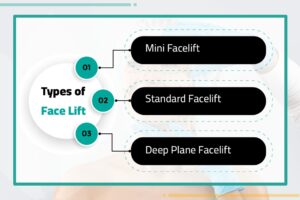Face Lift
A Face Lift is a surgical cosmetic operation used to rejuvenate the face. The process can lessen skin drooping. It can also aid in the smoothing of skin creases around the jawline and cheeks. Another name for a facelift is a rhytidectomy.
A skin flap is pulled back on each side of the face during a facelift. Excess skin is removed, and the tissues beneath the skin are changed. The face seems more youthful as a result.
A facelift frequently includes a neck lift. It lowers neck fat and skin sagging. Fine lines and wrinkles caused by sun exposure cannot be corrected by a facelift. Other cosmetic procedures can improve the skin’s appearance or quality.
The Rationale behind Its Completion
As people age, their faces alter in shape and appearance. The skin becomes less elastic and less readily snaps back. Certain parts of the face have less fat accumulation than others.
These aging-related alterations can be treated with a facelift:
- Look of sagging cheekbones.
- Surplus skin around the lower jaw.
- From the corners of the lips to the sides of the nose, there are deep skin folds.
- Excess fat and sagging skin in the neck (if a neck lift is part of the operation).
- Fine wrinkles, sun damage, creases around the nose and upper lip, and uneven skin tone cannot be treated with a face-lift.
Face Lift Procedure
First Step: Anesthesia
You will be given medication to help you feel comfortable throughout the surgical process. General anesthesia and intravenous sedation are the options. Your physician will advise you on the best course of action.
The results of a facelift can be further improved by a number of additional procedures. Among them are:
* Using fat transfer or facial implants to enhance shape.
* Methods for resurfacing the skin on the face to enhance its tone and texture.
* Injecting fillers or fat to reduce wrinkles.
Step 2: Making the Cut
Your options for a facelift are a regular facelift, a limited incision facelift, or a neck lift, depending on the extent of improvement you’d like to see. Typically, a typical facelift incision starts at the temple hairline, goes around the ear, and ends in the lower scalp. In addition to repositioning underlying tissue and sculpting or redistributing fat from the face, jowls, and neck, deeper layers of the face and muscles are frequently lifted. Excess skin is cut off and the skin is re-draped over the features that have been raised.
For an aging neck, it could be required to make a second incision beneath the chin. The wounds are sealed using sutures or skin adhesives.
Face Lift Steps
Step 3: Sealing the Wounds
After a few days, the sutures used to close the incisions may disintegrate or need to be removed. To seal the incisions, some surgeons apply skin glues. The scars from a facelift are nicely hidden by the hairline and the inherent features of the face and ear once they have healed.
Step 4: Examine the Outcomes
After bruising and swelling go down, a facelift’s noticeable benefits become apparent. The end effect should give you back a more refreshed and young appearance while also boosting your self-esteem. Find out more about the outcomes of facelifts.
Face Lift Cost
The price of a facelift in Turkey might differ significantly based on the degree of the treatment and from clinic to clinic. A minor facelift may cost small amount of dollars, while a face and neck lift may cost up to 3,000 USD. The price of any necessary consultations or follow-up care should also be considered.
Face Threading Near Me
If you’re searching in Turkey, look for treatment facilities that offer facelifts on the website of the Natural Beauty Turkey.
In Istanbul, all private clinics and hospitals offering cosmetic surgery have to be CQC certified. People can choose their care by using the CQC’s performance ratings and inspection reports.
Investigate the surgeon performing the facelift as well. At the very least, all medical professionals need to be registered with the General Medical Council (GMC). To determine whether a doctor is qualified to practice history, check the registration.
Why to Have Face Lifting?
The flexibility of our skin and the volume of our face tissues decrease with age. Deep creases, loose skin on the neck, and “jowls” on the lower face are the eventual outcomes of this. Although these are inevitable aspects of age, a facelift may be a viable option for people who find these indications of aging upsetting. Consider rhytidectomy if you can relate to any of the following:
1. Your drooping skin makes you feel self-conscious about the appearance of your face and neck.
2. You cover up your aged neck with scarves and turtlenecks, not because you want to.
3. You believe that your face makes you appear much older than you actually are when you glance in the mirror.
4. You believe that your job or personal relationships are suffering as a result of your aged appearance.
5. Patients often report feeling more confident after having a facelift because their appearance more accurately captures their vibrant, healthy personality.
What are the best Types of Body Sculpting?
Before Face Lifting Operation
- It is important to thoroughly assess the patient’s medical history. Chronic diseases and any prior long-term treatment should be taken into account. In the event that there are no surgical barriers, the patient and the physician should carefully plan the procedure’s location, scope, and day.
- Foods and medications that thin blood should be stopped 10 days prior to any surgical procedures.
- Giving up drinking and smoking should be done at least two weeks in advance.
- The patient might need to spend a day in the hospital, depending on the procedure.
- Your physician will notify you beforehand. It helps to have a partner beside you in this situation.
After Face Lifting Operation
- Following surgery, the nose and eyes are left uncovered by bandaging the face.
- It is normal to experience skin tension, minor sleepiness, swelling, and bruises.
- The patient wears a neck brace to reduce bruises and swelling. The edema will start to lessen at the conclusion of the first seven days.
- The sutures will be taken out once the bandage on your face is taken off.
- You can complete your everyday tasks during this phase without getting tired. Wearing a neck brace while you sleep will help.
- After the procedure, the patient can simply resume their regular activities as the bruises start to heal 15 days later. The loss of sensation in the face could last for a few weeks before going away entirely.
- During the first six months, direct sunlight must be avoided. Avoid solarium at all costs. Even though this varies from patient to patient, your new look is entirely entrenched after a full year.
- In addition to all of this information, it’s critical that you adhere to the precise advice given by your physician.
What Does Face Lift Surgery Include?
A general anesthetic is typically used during a facelift procedure. On occasion, sedation and a local anesthetic may be used during the procedure.
Although there are numerous varieties of facelifts, the surgeon will typically:
- Make incisions above the hairline at the temples that run down in front of your ear, underneath your earlobe, and behind your ear.
- If your jawline is also being lifted, make incisions under your chin.
- Remove any excess facial skin. Pull the remaining skin upward and backward before sewing it into place.
- Sometimes, add or redistribute fat to your face. Bandage your face to reduce swelling and bruises.
- Most patients need to spend the night in the hospital, and it typically takes two to three hours. If you are uncomfortable thereafter, pain treatment is given.
Face Lift Side Effects
Following a facelift, it’s typical to have:
* Bruising that can linger for a few weeks; a swollen or numb face that could persist for a few weeks or months; a stiff feeling in your mouth and face that normally goes away after six weeks
pain, depression for a few days.
* Scars: they should lighten, but they won’t go away entirely.
* A sideburn or elevated hairline.
* Decreased development of hair on the forehead’s sides (temples).
Thread Lift Near Me at Natural Beauty Turkey
A highly developed eye for aesthetic detail, a specific skill set of surgical methods, and thorough understanding of facial anatomy are all necessary for the difficult treatment known as rhytidectomy.
It is imperative to conduct thorough research prior to selecting a facelift surgeon as not all medical professionals who perform cosmetic surgery are trained in this procedure throughout their residency program.
Talk about the unique training and experience that prospective cosmetic surgeon have in doing facial cosmetic surgery. Inquire about the number of facelift procedures that each cosmetic surgeon has completed, and during your appointment, make sure to view a good number of before and after pictures.
This will help you gauge the aesthetic preferences of the surgeon. Men who are thinking about having a facelift should make sure the cosmetic surgeon has experience doing facelifts on men because the anatomy of a man’s face differs from that of a woman’s and calls for expertise.
Discover the Reasons of Dry Eye
Types of Face Lift

A cosmetic surgeon will adjust their approaches based on the specific demands of each patient throughout facelift surgery.
Mini Facelift
Individuals who have drooping skin and minor jowling are frequently excellent candidates for a mini-facelift. With shorter incisions made along the hairline above each ear and/or in the natural creases surrounding the ear, a cosmetic surgeon can use this less invasive procedure to tighten deep face tissues. The structural tissues surrounding the cheeks are elevated and tightened by these incisions, correcting jowling, smoothing the jawline, and revitalizing a “tired” appearance.
A mini-facelift may be done under general anesthesia or local anesthetic with sedation, depending on the circumstances; your cosmetic surgeon will advise you on the best course of action. By treating unwanted indications of aging before they become too noticeable, a mini-facelift can help you put off the need for more substantial surgery for many years.
Standard Facelift
The superficial musculoaponeurotic system (SMAS) procedure, sometimes referred to as a standard or traditional facelift, is a more comprehensive approach to treating moderate to advanced aging in the mid-face and neck region. The effects are more striking even if the procedure requires more time to recuperate from than a mini-facelift.
A cosmetic surgeon can realign the deeper tissues beneath the skin and remove excess skin to smooth creases, remove jowling and sagging skin under the chin, and restore a naturally youthful contour to the face and neck through incisions made just behind the hairline, starting near the temples and around the front of the ear, hidden in the natural folds.
Deep Plane Facelift
A deep plane facelift involves the repositioning of the face’s deeper tissues and structures, including the muscles. This gives the surgeon the ability to elevate the skin more thoroughly without pulling it taut, resulting in the best possible outcome while keeping the procedure looking natural.
Surgeons performing deep plane facelifts may additionally realign cheek fat pads to give the appearance of a more elevated midface region. Results from deep plane facelifts are thought to endure longer than those from the conventional SMAS technique.





